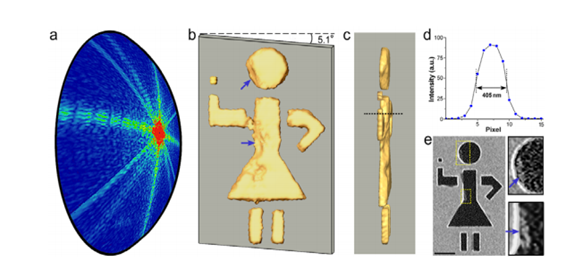The Puzzle of 3-D Images from a Single Shot
3-D imaging has always held a peculiar fascination for scientists and inventors. In general, 3-D imaging techniques require at least two view points to determine the 3-D structure.

And the most widely used for imaging molecules– diffraction imaging, tomography and confocal microscopy–require numerous images at different orientations or several scans in thin sections.
So there was huge interest when in 2009, Jianwei Miao at the University of California, Los Angeles and a few pals discovered how to create 3-D models of complex molecules from a single image. They called the technique ankylography derived from the Greek word ankylos, meaning curved, and the word graphein meaning writing.
Their thinking was that it ought to be possible to capture the complete 3-D structure from the diffraction pattern incident on a sphere. Instead of taking many images, an iterative algorithm could then distil the 3-D structure.
These guys demonstrated the technique numerically to reconstruct the shape of a poliovirus and also demonstrated it practically by reconstructing the 3-D shape shown above.
Since then the work has come in for some criticism. Other scientists have suggested that the technique cannot be scaled to objects of interesting size and that, in any case, it only works for things that are so thin that they are essentially two dimensional anyway.
Today, Miao and pals respond. They say the mathematical analysis suggesting that the technique only works for 2-D objects makes some unrealistic assumptions. In particular, it assumes that the spherical shell in which the image is recorded is infinitesimally thin.
By contrast, Miao and co say the shell has a finite thickness determined by the depth of the voxels used to capture the image. It is this, they say, that provides the extra information required for 3-D structure determination.
They also say that it is possible to use the technique for larger objects, for example by taking several images (although this partly undermines its original advantage).
Of course, Miao and co admit some limitations of ankylography but say the technique is so new that it is bound to require modification before it gains more widespread use.
The advantage of being able to image 3-D objects with a single shot is obviously huge. It ought to allow, for example, 3-D movies of molecules as they move or change shape. That’s tricky with other techniques when several shots are required to determine the structure at any instant.
3-D imaging techniques have a history of difficult births. This is clearly no exception.
Refs:
arxiv.org/abs/1112.4459 : Potential and Challenge of Ankylography
arxiv.org/abs/1001.4594: Fundamental Limits of “Ankylography” due to Dimensional Deficiency
arxiv.org/abs/0905.0269: Three-Dimensional Structure Determination From A Single View
Keep Reading
Most Popular
Large language models can do jaw-dropping things. But nobody knows exactly why.
And that's a problem. Figuring it out is one of the biggest scientific puzzles of our time and a crucial step towards controlling more powerful future models.
The problem with plug-in hybrids? Their drivers.
Plug-in hybrids are often sold as a transition to EVs, but new data from Europe shows we’re still underestimating the emissions they produce.
How scientists traced a mysterious covid case back to six toilets
When wastewater surveillance turns into a hunt for a single infected individual, the ethics get tricky.
Google DeepMind’s new generative model makes Super Mario–like games from scratch
Genie learns how to control games by watching hours and hours of video. It could help train next-gen robots too.
Stay connected
Get the latest updates from
MIT Technology Review
Discover special offers, top stories, upcoming events, and more.